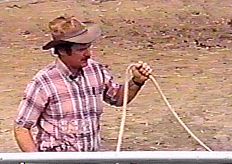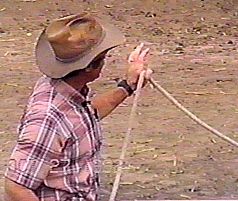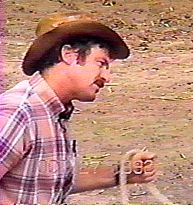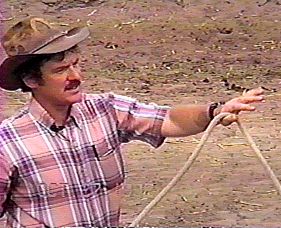Longe Line Logic
|
|
In Part One we discussed the basics of getting the horse working on the line, but how do you handle the rope in order to safely get the best results? Please note that I'm not wearing gloves in this feature in order to better illustrate hand and rope positions. In no way do I recommend handling horses without wearing appropriate gloves!
Key Points. Effectively controlling the horse is one objective. However getting those results safely is paramount. Improper handling of lead ropes have resulted in handlers literally getting their hands ripped off or dragged and trampled to death by the horse. This is serious business. Before we begin we need to discuss "death grips." Never leave a soft lead rope in loops around your hand. If the horse bolts the loops can instantly suck tight like a noose. You can get pulled off your feet and dragged and you could literally lose your hand. Never hold the rope palm up except for very specific maneuvers such as shaking the horse back using the rope. If the horse bolts and you can't check his movement, at minimum you'll have a very painful rope burn across your palm - even through some gloves. If the end of the rope flips up and around your arm the damage will likely be much worse. You have to be able to immediately drop the rope clear of your hand and arm if you lose control. |
| Always grip the rope with your little finger closest to the halter. You would hold the reins the same way. Your hand will be in a natural position and will not impede the movement of your arm in any direction. You will also be able to hold the horse using your biceps, which are the strongest muscles in your arm. (If you doubt this, hold onto a rope with someone tugging on you. Try holding it this way, then try holding it with your thumb forward. See for yourself which method gives you the most control, strength and balance and is less tiring.) |
|
| This grip will also allow you to make hand movements, gestures, slide out the rope, etc., with ease. If you have to quickly open up the palm of your hand to defend your space (such as placing it between you and the horse's eye), your thumb will act as a hook so you don't lose the rope and you can instantly regain hold of it if you need to. |
|
| Then if you need to get the horse's head back to disengage him, change directions, protect yourself from a kick or whatever, you can easily grip tight and pull the rope down alongside you. You can even "half sit" against the rope if you need to cut off a flight response. (Note: If you sit against the rope, be sure to do this just as the horse is welling up and not after he's gained some speed moving away from you! If in doubt, drop the rope. You can always start over if you don't get hurt.) |
|
| Just as easily as I brought his head into me, I can set up a wall to guide him past me or I can even step forward bringing my hand up by his eye in order to get him to yield. There are dozens of variations to these hand gestures which depend on the horse and the exact message that I am trying to convey. By holding the rope correctly, I can send virtually any message and not lose control of the rope and therefore not lose control of the horse. |
|
The next part will discuss techniques on how to teach the horse to back up by using the rope.
Continue to Part ThreeReturn to Part OneImportant Note: If you take on the project of developing an untrained horse, everybody will want to give you advice. Don't act on any advice, including the ideas offered in this site, unless it makes sense to you and fits your individual situation. Your abilities and the sensitivities of your horse(s) may differ from the examples given. Be alert and rational with your actions so neither you nor your horse will get hurt. This information is offered as illustrations of what we do and the reader must apply common sense since he or she is solely responsible for his or her actions. Happy trails!Press "Back" to return to the page that brought you hereGo to Case Study SectionReturn to Training SectionReturn to Wild Horse MentorsReturn to KBR World of Wild Horses and BurrosGo To
|




